Types of solar hot water systems
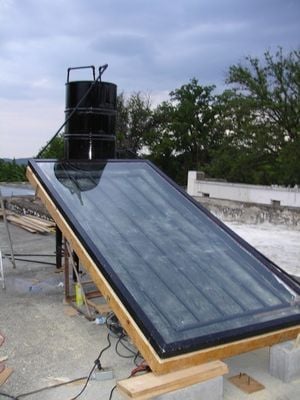
Solar hot water systems are designed to transfer the sun's solar energy to water. Finding the most efficient and effective solar hot water system for a given situation can be a challenging task. There are a number of key factors that need to be considered when choosing the most appropriate system configuration. These factors include, to a large extent, amount of solar insolation, climate, construction, installation and materials costs, location and accessibility of the system, amount of water needing heating, frequency of hot water use, availability of electricity, availability of materials, and skill level in construction.
The following classifications of systems are in three groups of two and one group of one unique system. These four main groups are:
- Open loop vs Closed loop.
- Active vs Passive.
- Uses a heat exchanger vs Does not use a heat exchanger.
- Batch system.
Any given system uses one characteristic from each group. For example, a system may be an active, open loop system which does not use a heat exchanger. Or another example, a system may be a passive, closed loop system which does use a heat exchanger. Some systems are much easier to make than others and people with a basic knowledge of tools and construction can easily make a functional system. If one desires to make their own system, this variability in complexity would influence what type of system is chosen.
Cost is another factor and each system configuration comes with a variety of different cost and benefits. The costs of any specific system can vary widely from country to country and region to region. Certain configurations using certain types of equipment are more efficient than others in specific situations. The following information gives an in depth look at these various ways of constructing hot water solar collectors.
Different types of collectors are also shown at the the end of this page as well as examples of different common solar hot water systems.
This page describes the various systems that are being used to heat up water with the sun. For a more general description of solar hot water visit the Solar hot water page.
Open loop systems[edit | edit source]
Open loop means that the water that requires heating flows directly through the hot water solar collector itself. There is no intermediary fluid. See Closed Loop heading below for the one exception to this definition where the water in a closed loop system flows directly through the solar collector. Open Loop systems do not use heat exchangers.
Advantages[edit | edit source]
Open loop systems are the simplest to design and construct. They generally require the least amount of construction and have the potential to last longer without serious maintenance due to their limited amount of moving parts.
Disadvantages[edit | edit source]
Open Loop systems are not ideal in areas where the temperatures can drop below freezing. The pipes can freeze causing the liquid water to expand into ice which will rupture the pipes. Before any freezing temperatures, the system must be drained to preserve the pipes. In areas where the temperatures drop below freezing, it is advised to use a closed loop system with a heat exchanger or implement one or more of a variety of techniques to prevent the freezing of the pipes. Preventative measures can come in the form of system drains, either manual or thermostat controlled, or a pump that pushes conventionally heated water through the system during cold weather. The system may also be designed so that the water drains out of the collector by gravity when the circulation pump is not running.
Closed loop systems[edit | edit source]
Closed loop systems are more complex to make and implement than Open loop systems as they can be used in a wider variety of climates. A closed loop system uses some kind of liquid that has a much lower freezing point than water, yet readily absorbs and releases heat. Antifreeze used in automotive radiators is a good example. This fluid passes through the solar collector, becomes heated, and moves into some type of heat exchanger. See Heat Exchanger Systems below. Due to the nature of Closed loop systems, Heat Exchangers are needed to transfer the heat from the collector to the water. Closed loop systems can also be used in radiant flooring or wall radiator applications to heat an area rather than water.
Advantages[edit | edit source]
Unlike most Open Loop systems, Closed Loop systems can be used in regions that experience temperatures below freezing. Due to the unique properties of water, pipes can burst when water freezes. This is prevented by using a fluid that has a much lower freezing point than water.
Disadvantages[edit | edit source]
Closed Loop systems require the use of a heat exchanger. This adds inefficiencies to the system that must be taken into consideration during the design and system sizing stage. Extra materials for the heat exchanger can also raise the cost of a system.
Active systems[edit | edit source]
Active systems are those that require external energy to function. Generally this energy comes in the form of an electric pump that pushes the fluid through the collector. It is not uncommon to find solar powered pumps as the external input. Solar pumping is appropriate in many circumstances due to the fact that the water is only being heated, and thus only needs to be pumped, when the sun is shining.
Advantages[edit | edit source]
Due to the nature of hydrology and thermodynamics, pumping of water through the collectors replaces the need to store the heated water above the collectors which can be challenging and restrictive to design (See Passive Systems for further explanation).
Disadvantages[edit | edit source]
The use of a pump requires both the purchasing of a pump, as well as the need for a power source, most likely electricity, to power the pump.
Passive systems[edit | edit source]
Also known as Thermosiphon System, Passive type solar systems are those which do not use an outside power source. Passive Solar is a term that is applied to much more than just solar hot water. For example, painting a swimming pool black so as to absorb more energy, or putting windows on the south side of a house (in the northern hemisphere) in order to let in more of the sun's energy are both considered Passive Solar.
A Passive Solar water heater must take into account the physics surrounding hydrology and thermodynamics. This type of system uses a thermosiphon. A thermosiphon uses the energy of the sun to move water or other collector fluid in a vertical direction. This occurs when a liquid has varying temperature, and thus density differences. Because the hottest water will always move upward in, thus displacing the colder water downward, the hot water storage tank or Heat Exchanger must be above the solar collector.
Advantages[edit | edit source]
No external energy is needed in order to move liquid through the system. Less moving parts equals less things to break.
Disadvantages[edit | edit source]
If a hot water tank or heat exchanger is used, it must be positioned above the solar collector in order for the thermosiphon to flow. This can cause problems as most solar systems are on roofs of houses. Many design options are now available that facilitate the storing of hot water above the system.
Heat exchanger systems[edit | edit source]
Heat Exchangers are used in regions that experience temperatures less than freezing. Heat Exchangers themselves are built into a closed loop system and transfer the heat gathered in the collector to the house's hot water supply. There are a number of designs for heat exchangers.
A common design is to supplement a conventional hot water heater by transferring the heat from the solar collector fluid into the hot water tank. Copper tubing is a good material for readily transferring heat energy of a liquid.
Another common style of heat exchanger uses a barrel with two lines of copper paralleling each other. One tube comes from the solar collector, enters the barrel at the top, spirals around the edge of the barrel, comes out of the barrel at the bottom, and completes the closed loop by returning to the solar collector. The other tube that parallels the first is the household hot water supply. It enters the barrel at the bottom, parallels the collector tubing to the top of the barrel, and exits the barrel at the top, with hot water. The heat is transfered from the hot fluid from the collector, through the copper tubing, and into the household water. The barrel can be insulated on the outside to increase efficiency of transfer.
There are a number of different fluids that can be used in the closed loop system. The following are the more widely used and readily available liquids: glycol/water mixtures, hydrocarbon oils, refrigerants/automotive antifreeze, and silicones. Each of these have benefits and disadvantages. Refer to this EERE reference link to find out more.[1]
Advantages[edit | edit source]
Heat exchangers are used for a couple main reasons: to protect the system against freezing, and as one option to supplement another source of water heating.
Disadvantages[edit | edit source]
Heat Exchangers add complexity to a hot water system. There are more aspects of a system that must be designed and planned for when using a Heat Exchanger. There is also a greater chance of things breaking or not functioning properly due to the added components. Caution must also be taken to insure that the collector fluid is either non toxic, or that there is very little chance of the collector fluid contaminating the potable water supply should there be ruptures in the closed loop system.
Non-heat exchanger systems[edit | edit source]
These are systems where the potable water to be heated flows directly through the solar collector. This type of system is an Open Loop system.
Advantages[edit | edit source]
See Open Loop System
Disadvantages[edit | edit source]
See Open Loop System
Batch systems[edit | edit source]
Also known as Breadbox, or Integral Collector-Storage (ICS) Systems, these include one or more black tanks or tubes in an insulated, glazed box. It could even be as simple as painting a tank black, putting it in a crate, insulating it on all sides except the one that is pointing at the sun, and covering that sun exposed side with glass or plastic. As the sun warms the water it expands and becomes less dense, encouraging the hot water to flow to the top of the collector. From there it is drawn out into the house as needed or into an auxiliary tank for storage. These work best in areas where freezing temperatures are rare. Despite their climate restrictions they work relatively well; in colder climates they can be used seasonally and drained before harsh winter months.
Collectors[edit | edit source]
Unglazed[edit | edit source]
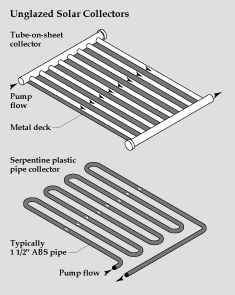
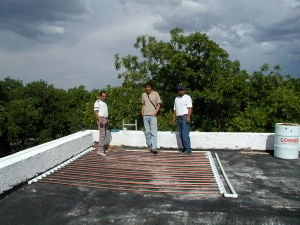
Glazed[edit | edit source]
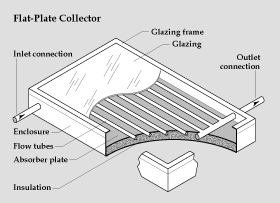
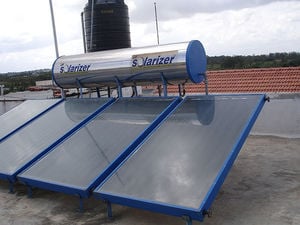
Evacuated tube[edit | edit source]

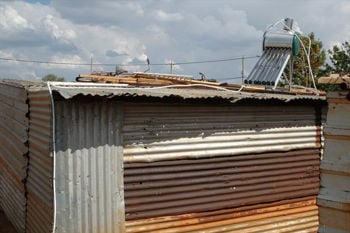
Batch collector[edit | edit source]
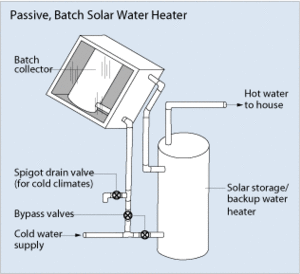
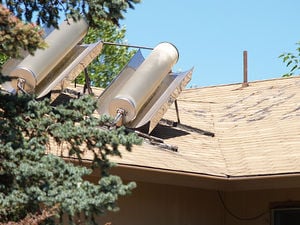
see http://commons.wikimedia.org/wiki/File:BatchSolarHeater.JPG
Examples[edit | edit source]
Active closed loop system[edit | edit source]
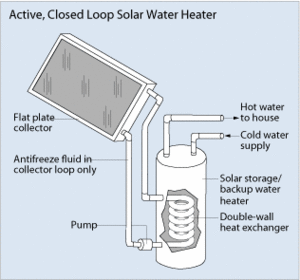
Active open loop system[edit | edit source]
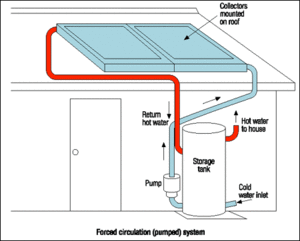
Passive closed loop system[edit | edit source]

Passive open loop system[edit | edit source]
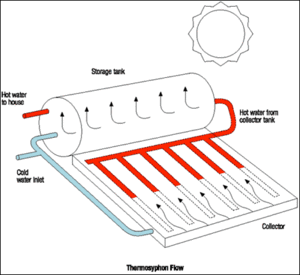
References[edit | edit source]
- ↑ US Dept of Energy. EERE Consumer Guide: Heat-Transfer Fluids for Solar Water Heating Systems. http://www.eere.energy.gov/consumer/your_home/water_heating/index.cfm/mytopic=12940
http://www.builditsolar.com/Projects/WaterHeating/ISPWH/IPSWH.pdf Download "The Integral Passive Solar Water Heater Book" by David Bainbridge